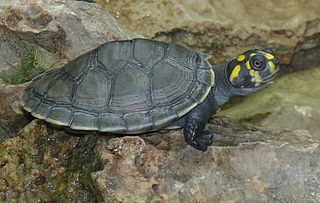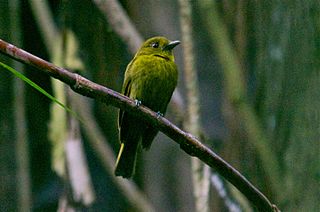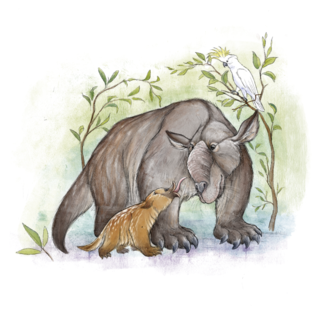
The Cenozoic Era is Earth's current geological era, representing the last 66 million years of Earth's history. It is characterized by the dominance of mammals, insects, birds and angiosperms. It is the latest of three geological eras of the Phanerozoic Eon, preceded by the Mesozoic and Paleozoic. The Cenozoic started with the Cretaceous–Paleogene extinction event, when many species, including the non-avian dinosaurs, became extinct in an event attributed by most experts to the impact of a large asteroid or other celestial body, the Chicxulub impactor.

The Oligocene is a geologic epoch of the Paleogene Period that extends from about 33.9 million to 23 million years before the present. As with other older geologic periods, the rock beds that define the epoch are well identified but the exact dates of the start and end of the epoch are slightly uncertain. The name Oligocene was coined in 1854 by the German paleontologist Heinrich Ernst Beyrich from his studies of marine beds in Belgium and Germany. The name comes from Ancient Greek ὀλίγος (olígos) 'few' and καινός (kainós) 'new', and refers to the sparsity of extant forms of molluscs. The Oligocene is preceded by the Eocene Epoch and is followed by the Miocene Epoch. The Oligocene is the third and final epoch of the Paleogene Period.

The Paleogene Period is a geologic period and system that spans 43 million years from the end of the Cretaceous Period 66 Ma to the beginning of the Neogene Period 23.04 Ma. It is the first period of the Cenozoic Era, the tenth period of the Phanerozoic and is divided into the Paleocene, Eocene, and Oligocene epochs. The earlier term Tertiary Period was used to define the time now covered by the Paleogene Period and subsequent Neogene Period; despite no longer being recognized as a formal stratigraphic term, "Tertiary" still sometimes remains in informal use. Paleogene is often abbreviated "Pg", although the United States Geological Survey uses the abbreviation "Pe" for the Paleogene on the Survey's geologic maps.

A passerine is any bird of the order Passeriformes which includes more than half of all bird species. Sometimes known as perching birds, passerines generally have an anisodactyl arrangement of their toes, which facilitates perching.

The New Zealand wrens are a family (Acanthisittidae) of tiny passerines endemic to New Zealand. They were represented by seven Holocene species in four or five genera, although only two species in two genera survive today. They are understood to form a distinct lineage within the passerines, but authorities differ on their assignment to the oscines or suboscines. More recent studies suggest that they form a third, most ancient, suborder Acanthisitti and have no living close relatives at all. They are called "wrens" because of similarities in appearance and behaviour to the true wrens (Troglodytidae) but are not members of that family.

The Tyranni (suboscines) are a suborder of passerine birds that includes more than 1,000 species, a large majority of which are South American. It is named after the type genus Tyrannus. These have a different anatomy of the syrinx musculature than the oscines, hence the common name of suboscines.

Podocnemididae is a family of pleurodire (side-necked) turtles, once widely distributed. Most of its 41 genera and 57 species are now extinct. Seven of its eight surviving species are native to South America: the genus Peltocephalus, with two species, only one of which is extant ; and the genus Podocnemis, with six living species of South American side-necked river turtles and four extinct. There is also one genus native to Madagascar: Erymnochelys, the Madagascan big-headed turtle, whose single species E. madagascariensis.

The sapayoa or broad-billed sapayoa is a suboscine passerine bird found Colombia, Ecuador, and Panama.

The Moridae are a family of cod-like fishes, known as codlings, hakelings, and moras.

The Paratethys sea, Paratethys ocean, Paratethys realm or just Paratethys, was a large shallow inland sea that covered much of mainland Europe and parts of western Asia during the middle to late Cenozoic, from the late Paleogene to the late Neogene. At its greatest extent, it stretched from the region north of the Alps over Central Europe to the Aral Sea in Central Asia.

Palorchestidae is an extinct family of vombatiform marsupials whose members are sometimes referred to as marsupial tapirs due to the retracted nasal region of their skulls causing them to superficially resemble those of true tapirs. The idea that they had a tapir-like trunk has been contested, with other authors contending that it is more likely that they had a prehensile lip and protrusible tongue instead. While earlier representatives like Propalorchestes had relatively unspecialsed forelimbs, the last member of the family, Palorchestes developed unusual clawed forelimbs with a morphology unlike that of any living animal, which were likely used to tear vegetation. They are suggested to have been browsers. The group experienced an increase in body size over time, with Propalorchestes weighing around 150 kilograms (330 lb), while the last known species, Palorchestes azael may have exceeded a ton. They are considered to be members of Diprotodontoidea, most closely related to the also extinct Diprotodontidae. Their closest living relatives are wombats.
Eurotrochilus is an extinct genus of stem group hummingbirds (Trochilidae) and are the closest known relatives of the crown group Trochilidae. Despite Eurotrochilus being morphologically very similar to modern hummingbirds, they still retained several primitive features and are not closely related to any specific extant hummingbird in the crown group. There are currently two described species of Eurotrochilus: E. inexpectatus and E. noniewiczi.

Palimphyes is an extinct genus of marine ray-finned fish known from the Paleogene period. It was a euzaphlegid, an extinct family of scombroid fish related to the escolars and snake mackerels.
Jamna is an extinct passeriform bird from early Oligocene deposits of Poland. It has been concluded as a frugivore or omnivore that lived in forests and shrubs. A 2024 study found it to represent a basal passeriform with no close relatives, being the sister group to all other extant passeriforms.

Resoviaornis is an extinct genus of passerine bird from the Early Oligocene of southern Poland. Only one species is recorded for the genus, Resoviaornis jamrozi. A 2024 study affirmed it as being an early songbird, with potential affinities to either the Passerides or Corvides.

The Alosidae, or the shads, are a family of clupeiform fishes. The family currently comprises four genera worldwide, and about 32 species.

Wieslochia weissi is an extinct species of passerine bird from the early Oligocene of Germany. Remains of this species have been found in a clay pit in Frauenweiler near Wiesloch, Germany. The holotype is a dissociated skeleton on two slabs. Another specimen consisting of a mandible and a cranium has been found in the same geological area. The taxonomic affinities of Wieslochia are not well understood as it shares some similarities with suboscines but it seems more primitive in other features. It was first described by Gerald Mayr and Albrecht Manegold. A 2024 study found strong support for it and the related Crosnoornis being members of the Tyranni, either as stem group or crown group members of the Eurylaimides.
Winnicavis is a genus of passerine bird from the Early Oligocene of Poland.
Sobniogallus is an extinct genus of galliform bird that inhabited Poland during the Rupelian stage of the Oligocene epoch. It is a monotypic genus known from the species S. albinojamrozi.
















